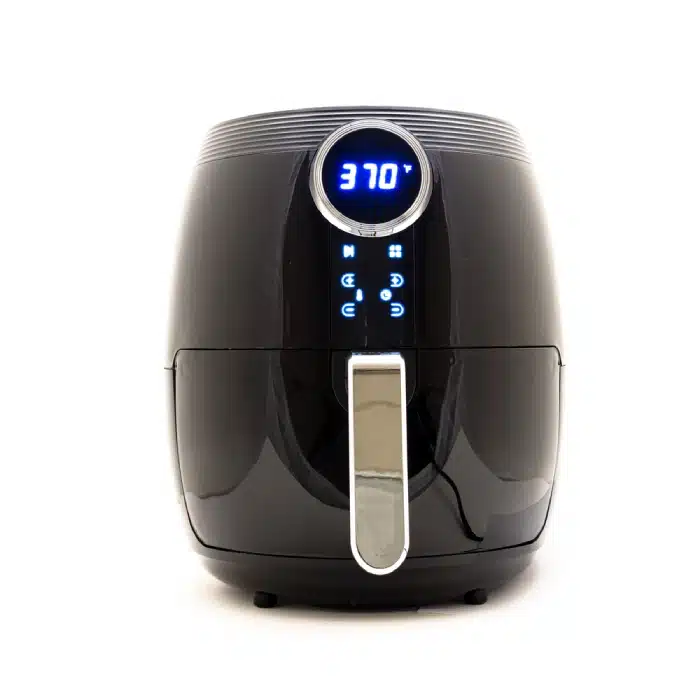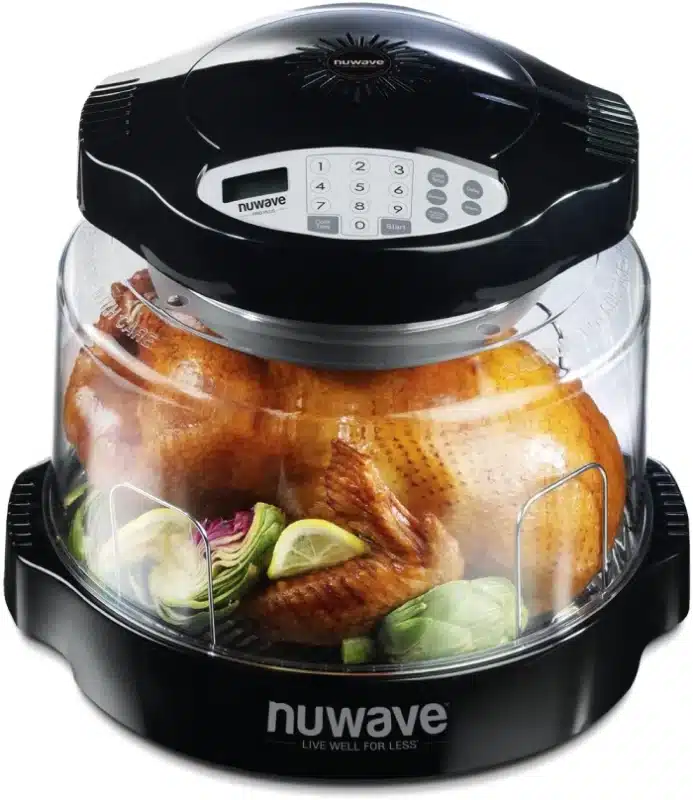We've independently reviewed this article to make sure it's as accurate as we can make it.
To find out more about our article creation and review process, check out our editorial guidelines.
Confused about the differences between NuWave ovens vs air fryers?
You’re not alone! Both appliances have similarities, which can make choosing between them quite challenging.
The good news is that you’ve come to the right place for answers.
When comparing NuWave ovens vs air fryers, you need to consider your needs and preferences. While both can help you cook with less fat, NuWave ovens are more versatile and convenient. However, air fryers are less expensive and great for smaller families.
Which is the better option? Let’s find out.
Can You Use a Nuwave Oven as an Air Fryer?
Although there are some differences between both, you can use a NuWave Oven as an air fryer.
I like that NuWave infrared ovens are capable of baking, broiling, roasting, barbecuing, and grilling. They can also steam, dehydrate, and air fry.
The NuWave Oven can get you that healthier fried crisp and taste. It is also larger in capacity than the average air fryer, so it can also fry larger quantities of food at one time.
However, there are other differences you need to keep in mind when choosing between a NuWave Oven and an air fryer. Read on to learn more!
NuWave Ovens vs Air Fryers
In this section, I’ll explain the main differences between NuWave ovens and air fryers so you can decide which one is worth your investment.
#1 Cooking Method
One of the main differences between air fryers and NuWave ovens is their cooking method.
Despite the name, air fryers don’t actually fry anything. Air fryers circulate hot air around your food to cook it and provide a tasty crisp with little to no oil.

NuWave ovens, on the other hand, cook in three different ways. They use infrared, conduction, and convection. I won’t turn this into a science lecture, but I’ll briefly explain how these heat transfer methods cook your food.

Conduction is the most basic of heat transfers. Simply put, a hot thing makes a cold or cool thing hot too. You preheat your oven to make the interior hot. Once heated, you place your food inside, and the heat transfers.
Convection is the method of cooking air fryers use. Convection involves hot air being circulated with a fan to surround the food and cook it. It’s much like conduction but adds movement.
Infrared is the unique aspect of the NuWave. It involves energy waves that are absorbed by the food to heat it. In a NuWave infrared oven, shields and reflectors help transfer energy waves.
The three different ways in which a NuWave Oven cooks helps it use up to 75% less energy than traditional cooking.
#2 Health
Now, let’s compare the healthiness of air fryers and NuWave ovens.
Good news! No matter which appliance you choose, you’ll get a healthy option. In my experience, both cook food with minimal fats and oils.
The NuWave Oven is known for removing and collecting fats and oils. In fact, the oven was tested by a third party (Silliker Inc.) and was found to collect 250% more fat drippings than traditional ovens.
Consider the possibilities – if you cook chicken, fish, or any meat, you’re getting less fat than its convection oven-cooked counterpart.
Air fryers don’t collect oils, but they don’t use extra, to begin with. Air fryers use little to no oil to fry, so you get the crisp with less fat.
#3 Versatility
In my opinion, the air fryer doesn’t stack up to the NuWave infrared oven in terms of versatility.
Air fryers do more than make fried chicken, certainly. For example, did you know you make stuffed bell peppers in an air fryer? Some crafty home chefs have even found ways to bake in their air fryers.
However, a NuWave Oven takes versatility to another level. It doesn’t just roast chickens or grill burgers; it can also dehydrate, air fry, bake, and practically do it all.
Note: If you love baking, keep in mind that while NuWave’s cooking capabilities extend further, some users find infrared-baked goods a bit dry.
#4 Convenience
Now, let’s compare NuWave vs air fryers regarding convenience.
Air fryers are convenient for what they do. They’re easy to use and clean.
However, I find that NuWave ovens are more convenient because they can cook multiple foods simultaneously.
Since a NuWave Oven has a larger capacity (10 quarts to air fryers’ six or below) and has triple combo cooking, you could theoretically prepare an entire meal.
Yes, you could put an entire chicken and your veggie sides all together!
#5 Time
If you’re still unsure whether to buy an air fryer or a NuWave oven, consider the cooking time and preparation required for each appliance.
While both appliances are speedy, the NuWave inches ahead ever so slightly.
To illustrate, we will consider chicken. According to the NuWave cookbook, a chicken breast will take about 8 minutes when on the HI setting. On the other hand, that same piece of meat will take almost 20 minutes in an air fryer.
Understandably, a nearly 10-minute difference probably won’t impress you. Consider, though, your prep time.
NuWave Oven does not require preheating, while the air fryer does. Preheating can add additional 10 minutes to your preparation time.
#6 Price
You’ll also need to consider your budget when choosing between an air fryer and a NuWave oven.
Air fryers vary in price. As I type these words, you can buy several types of air fryers on sale for $20. The average price for one is typically around $70, but you can pay up to $300 for a high-end model.
NuWave ovens certainly aren’t on sale for $20. If you want a NuWave infrared oven, you’ll have to pay over $140. And if you want one of the brand’s kits, like a baking, pizza, or dehydrating kit, the costs really start to add up.
So, if you’re on a budget, air fryers are the way to go.
Maintenance and upkeep are important as well. To work, the NuWave Oven requires a plastic dome. It isn’t the strongest of materials, and I’ve seen that customers find it breaks sooner rather than later.
You could always buy a replacement dome, of course. NuWave sells these domes for $35.
NuWave Ovens vs Air Fryers – Pros and Cons
To help you choose between an air fryer and a NuWave oven, let’s compare their pros and cons.
NuWave Ovens
| Pros | Cons |
|---|---|
| Use less energy | Short lifespan |
| No preheating | Expensive |
| Fast cooking times | Pricey accessories/kits |
| Larger capacities | Large, takes up space |
| Can cook multiple foods separately | |
| Dishwasher safe parts | |
| Easy-to-use control panel |
Air Fryers
| Pros | Cons |
|---|---|
| Affordable | Limited to one cooking method |
| Healthier fried foods | Limited basket size |
| Variety of sizes | Longer cooking times |
| Easy-to-use | |
| Dishwasher safe parts |
Final Verdict: Air Fryer or NuWave Oven?
Hopefully, now you know all the differences between an air fryer and a NuWave Oven.
Remember that the best countertop cooker depends on what you need it for. NuWave ovens offer cooking versatility, while air fryers give an affordable and healthy way to fry foods. Both are easy to use and clean but will also take up valuable counter space!
Thank you so much for reading. If you have any other decisions to make, why not check out some of our other guides below?
Have a great day!







